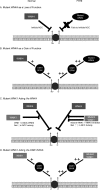Molecular physiology of the thiazide-sensitive sodium-chloride cotransporter
- PMID: 19636250
- PMCID: PMC2947818
- DOI: 10.1097/MNH.0b013e32832f2fcb
Molecular physiology of the thiazide-sensitive sodium-chloride cotransporter
Abstract
Purpose of review: This review summarizes recent advances in the understanding of the molecular physiology and regulation of the thiazide-sensitive sodium-chloride cotransporter (NCC).
Recent findings: Mutations of with-no-lysine (WNK) kinases 1 and 4 result in hyperactivity of NCC and familial hyperkalemic hypertension, a genetic syndrome of hypertension. Recent studies have shown that WNK1 and WNK4 activate the STE20 family protein kinases Ste20-related proline/alanine-rich kinase and odd-skipped-related 1, resulting in phosphorylation and activation of NCC. Additionally, a mouse knock-in model for a WNK4 familial hyperkalemic hypertension mutant demonstrated increased Ste20-related proline/alanine-rich kinase/odd-skipped-related 1 and NCC phosphorylation. It is unclear how these studies fit with the data indicating that WNK4 inhibits NCC, and the familial hyperkalemic hypertension mutations of WNK4 are loss-of-function mutations. Another WNK kinase, WNK3, also regulates NCC, activating NCC and antagonizing the effect of WNK4. Extracellular signal-related kinase 1/2 mitogen-activated protein kinase activation by Ras guanyl nucleotide-releasing protein 1 is another kinase pathway that appears to be a potent regulator of NCC. Other studies have described a role for angiotensin II in pressure natriuresis via actions on NCC. Recent studies examining the hormonal regulation of NCC have implicated angiotensin II and aldosterone in regulation of the WNK4-Ste20-related proline/alanine-rich kinase-NCC pathway.
Summary: NCC is subject to a complex regulatory network of kinases, which appear quite sensitive to alterations of the hormonal and physiologic milieu.
Figures


Similar articles
-
WNK-SPAK-NCC cascade revisited: WNK1 stimulates the activity of the Na-Cl cotransporter via SPAK, an effect antagonized by WNK4.Hypertension. 2014 Nov;64(5):1047-53. doi: 10.1161/HYPERTENSIONAHA.114.04036. Epub 2014 Aug 11. Hypertension. 2014. PMID: 25113964 Free PMC article.
-
The thiazide-sensitive Na-Cl cotransporter is regulated by a WNK kinase signaling complex.J Clin Invest. 2007 Nov;117(11):3403-11. doi: 10.1172/JCI32033. J Clin Invest. 2007. PMID: 17975670 Free PMC article.
-
Aldosterone modulates thiazide-sensitive sodium chloride cotransporter abundance via DUSP6-mediated ERK1/2 signaling pathway.Am J Physiol Renal Physiol. 2015 May 15;308(10):F1119-27. doi: 10.1152/ajprenal.00543.2014. Epub 2015 Mar 11. Am J Physiol Renal Physiol. 2015. PMID: 25761881 Free PMC article.
-
A unifying mechanism for WNK kinase regulation of sodium-chloride cotransporter.Pflugers Arch. 2015 Nov;467(11):2235-41. doi: 10.1007/s00424-015-1708-2. Epub 2015 Apr 24. Pflugers Arch. 2015. PMID: 25904388 Free PMC article. Review.
-
Molecular insights from dysregulation of the thiazide-sensitive WNK/SPAK/NCC pathway in the kidney: Gordon syndrome and thiazide-induced hyponatraemia.Clin Exp Pharmacol Physiol. 2013 Dec;40(12):876-84. doi: 10.1111/1440-1681.12115. Clin Exp Pharmacol Physiol. 2013. PMID: 23683032 Review.
Cited by
-
Potentiation of the effect of thiazide derivatives by carbonic anhydrase inhibitors: molecular mechanisms and potential clinical implications.PLoS One. 2013 Nov 18;8(11):e79327. doi: 10.1371/journal.pone.0079327. eCollection 2013. PLoS One. 2013. PMID: 24260196 Free PMC article.
-
Regulated endocytosis of NCC.Am J Physiol Renal Physiol. 2010 Aug;299(2):F297-9. doi: 10.1152/ajprenal.00280.2010. Epub 2010 May 26. Am J Physiol Renal Physiol. 2010. PMID: 20504880 Free PMC article. No abstract available.
-
A role for the circadian clock protein Per1 in the regulation of the NaCl co-transporter (NCC) and the with-no-lysine kinase (WNK) cascade in mouse distal convoluted tubule cells.J Biol Chem. 2014 Apr 25;289(17):11791-11806. doi: 10.1074/jbc.M113.531095. Epub 2014 Mar 7. J Biol Chem. 2014. PMID: 24610784 Free PMC article.
-
Hypertrophy in the Distal Convoluted Tubule of an 11β-Hydroxysteroid Dehydrogenase Type 2 Knockout Model.J Am Soc Nephrol. 2015 Jul;26(7):1537-48. doi: 10.1681/ASN.2013060634. Epub 2014 Oct 27. J Am Soc Nephrol. 2015. PMID: 25349206 Free PMC article.
-
Aldosterone: Renal Action and Physiological Effects.Compr Physiol. 2023 Mar 30;13(2):4409-4491. doi: 10.1002/cphy.c190043. Compr Physiol. 2023. PMID: 36994769 Free PMC article.
References
-
- Gamba G, Miyanoshita A, Lombardi M, et al. Molecular cloning, primary structure, and characterization of two members of the mammalian electroneutral sodium-(potassium)-chloride cotransporter family expressed in kidney. J. Biol. Chem. 1994;269:17713–17722. - PubMed
-
- Chobanian AV, Bakris GL, Black HR, et al. Seventh report of the Joint National Committee on Prevention, Detection, Evaluation, and Treatment of High Blood Pressure. Hypertension. 2003;42:1206–52. - PubMed
-
- Gordon RD, Hodsman GP. The syndrome of hypertension and hyperkalaemia without renal failure: long term correction by thiazide diuretic. Scott Med J. 1986;31:43–4. - PubMed
-
- Gitelman HJ, Graham JB, Welt LG. A new familial disorder characterized by hypokalemia and hypomagnesemia. Trans Assoc Am Physicians. 1966;79:221–35. - PubMed
-
- Wilson FH, Disse-Nicodeme S, Choate KA, et al. Human Hypertension Caused by Mutations in WNK Kinases. Science. 2001;293:1107–1112. - PubMed
Publication types
MeSH terms
Substances
Grants and funding
LinkOut - more resources
Full Text Sources
Research Materials

